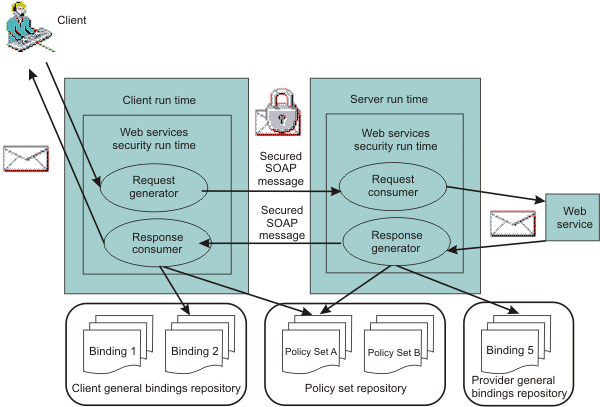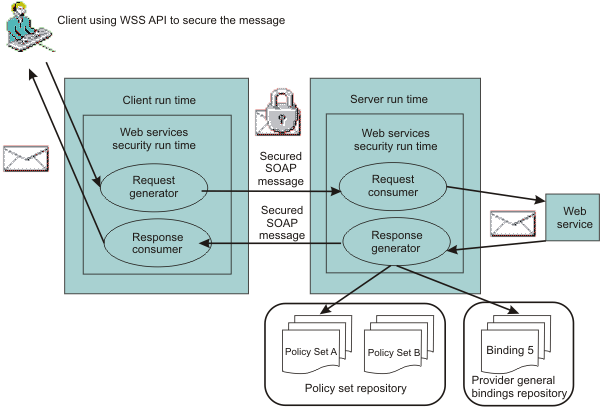Network Deployment (Distributed operating systems), v8.0 > Secure applications and their environment > Secure web services > Secure web services > Web Services Security concepts > Web Services Security concepts > Web Services Security provides message integrity, confidentiality, and authentication
High-level architecture for Web Services Security
The Web Services Security policy is specified in the IBM extension of the web services deployment descriptors when using JAX-RPC, and in policy sets when using JAX-WS. A stand-alone JAX-WS client application may specify Web Services Security policy programmatically. Binding data that supports the Web Services Security policy are stored in the IBM extension of the web services deployment descriptors for both the JAX-RPC and JAX-WS programming models. The Web Services Security run time enforces the security assertions specified in the policy document, or in the application program, in that order.
IBM WAS supports the JAX-WS programming model and JAX-RPC. JAX-WS is the next generation web services programming model extending the foundation provided by JAX-RPC. Using the strategic JAX-WS programming model, development of web services and clients is simplified through support of a standards-based annotations model. Although JAX-RPC and applications are still supported, take advantage of the easy-to-implement JAX-WS programming model to develop new web services applications and clients. bprac
WAS uses the Java EE Version 1.4 or later web services deployment model to implement Web Services Security. One of the advantages of deployment model is that you can define the Web Services Security requirements outside of the application business logic. With the separation of roles, the application developer can focus on the business logic and the security expert can specify the security requirement.
The following figure shows the high-level architecture model used to secure web services in WAS:

The WSS API can also be used to secure the message, as illustrated below:

There are two sets of configurations on both the client side and the server side:
WAS does not include security policy negotiation or exchange between the client and server. This security policy negotiation, as defined by the WS-Policy, WS-PolicyAssertion, and WS-SecurityPolicy specifications, are not supported in WAS.
The Web Services Security requirements that are defined in the request generator must match the request consumer. The requirements that are defined in the response generator must match the response consumer. Otherwise, the request or response is rejected because the Web Services Security constraints cannot be met by the request consumer and response consumer.
The format of the Web Services Security deployment descriptors and bindings are IBM proprietary. However, the following tools are available to edit the deployment descriptors and bindings:
Related
Security model mixture
Overview of platform configuration and bindings
Default configuration
Default implementations of the Web Services Security service provider programming interfaces
Assembly tools
Web Services Security provides message integrity, confidentiality, and authentication
Related
Request generator (sender) binding configuration settings
Request consumer (receiver) binding configuration settings
Response generator (sender) binding configuration settings
Response consumer (receiver) binding configuration settings